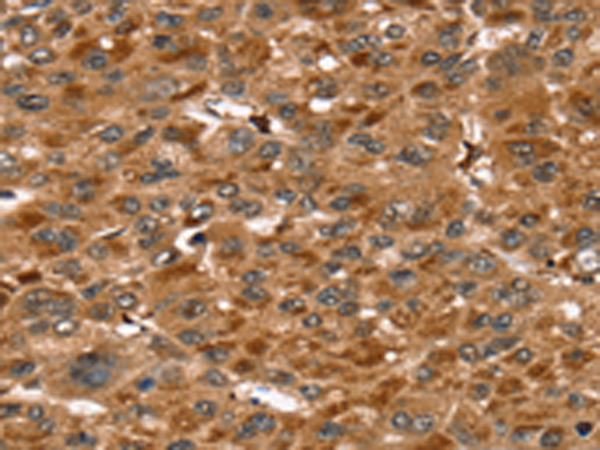
| WB | 咨询技术 | Human,Mouse,Rat |
| IF | 咨询技术 | Human,Mouse,Rat |
| IHC | 1/25-1/100 | Human,Mouse,Rat |
| ICC | 技术咨询 | Human,Mouse,Rat |
| FCM | 咨询技术 | Human,Mouse,Rat |
| Elisa | 1/2000-1/5000 | Human,Mouse,Rat |
| Aliases | PPG; PRG; PRG1 |
| Host/Isotype | Rabbit IgG |
| Antibody Type | Primary antibody |
| Storage | Store at 4°C short term. Aliquot and store at -20°C long term. Avoid freeze/thaw cycles. |
| Species Reactivity | Human |
| Immunogen | Fusion protein of human SRGN |
| Formulation | Purified antibody in PBS with 0.05% sodium azide and 50% glycerol. |
+ +
以下是3篇关于SRGN抗体的参考文献,按格式整理:
---
1. **文献名称**:Serglycin as a potential biomarker for prognosis in human colorectal cancer
**作者**:Wang, H., et al.
**摘要**:该研究通过免疫组化分析SRGN蛋白在结直肠癌组织中的表达,发现SRGN高表达与患者不良预后相关。使用特异性SRGN抗体证实其在肿瘤微环境中的分泌颗粒定位,提示其作为治疗靶点的潜力。
---
2. **文献名称**:Role of serglycin in tumor cell invasion and crosstalk with macrophages
**作者**:Korpetinou, A., et al.
**摘要**:研究利用SRGN抗体通过Western blot和免疫荧光技术,发现SRGN通过调控基质金属蛋白酶(MMPs)促进肿瘤细胞侵袭,并揭示其与肿瘤相关巨噬细胞互作的分子机制,为癌症转移提供新见解。
---
3. **文献名称**:Serglycin promotes hepatocellular carcinoma progression via activating NF-κB pathway
**作者**:Li, X., et al.
**摘要**:该文献使用SRGN抗体进行免疫沉淀和功能实验,证明肝癌细胞中SRGN通过激活NF-κB信号通路增强肿瘤生长和耐药性,提示靶向SRGN可能改善肝癌治疗反应。
---
4. **文献名称**:Serglycin in inflammation: Insights from knockout mouse models
**作者**:Schick, B.P., et al.
**摘要**:通过构建SRGN基因敲除小鼠,结合抗体染色和流式细胞术,研究发现SRGN缺失导致肥大细胞颗粒形成异常,显著降低炎症反应强度,证实SRGN在免疫细胞颗粒功能中的关键作用。
---
以上文献均涉及SRGN抗体的实验应用,涵盖癌症机制、预后标志物及炎症研究。如需具体期刊信息或补充其他研究,可进一步调整。
Serglycin (SRGN) antibodies target a proteoglycan initially identified in hematopoietic cells, where it plays a key role in storing and secreting granular components (e.g., proteases, cytokines) within vesicles. SRGN consists of a core protein modified by glycosaminoglycan (GAG) chains, typically chondroitin sulfate, which mediate interactions with extracellular ligands. Beyond its physiological roles in immune cells, SRGN is implicated in cancer progression. Overexpression of SRGN in tumor cells or tumor-associated stromal cells (e.g., macrophages) correlates with enhanced metastasis, angiogenesis, and chemoresistance. SRGN facilitates these effects by modulating signaling pathways (e.g., NF-κB, STAT3) and extracellular matrix remodeling.
Antibodies against SRGN have emerged as tools for studying its functional contributions to disease. They enable detection of SRGN expression in tissues, serving as potential biomarkers for aggressive cancers. Therapeutic applications are under exploration, particularly in blocking SRGN-mediated interactions that promote tumor-microenvironment crosstalk. Challenges include SRGN’s structural heterogeneity (due to variable GAG modifications) and its dual roles in different cell types, necessitating antibody specificity validation. Recent studies also highlight SRGN’s involvement in non-cancer pathologies (e.g., inflammation), expanding its relevance as a target. Current research focuses on optimizing SRGN antibodies for diagnostic and therapeutic precision.
×